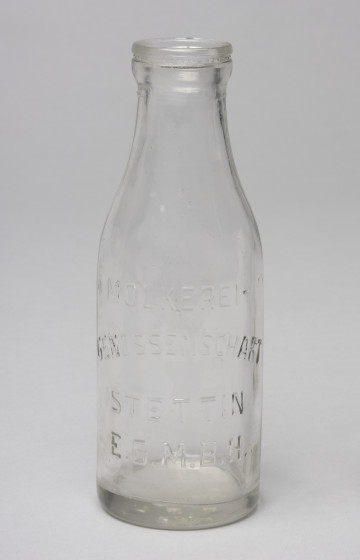
Grain basket
1900 — 1950
National Museum in Szczecin
Part of the collection: Folk ceramics
Stoneware is an excellent raw material for the storage of all kinds of liquids: water, spirits, oil, paraffin or solids – especially food. It is fired from a mixture of clay, chamotte and quartz sand at a temperature above 1200° C, and is covered with salt (NaCl) before firing. This increases resistance to acidity, which makes it highly suitable for the production and storage of fermented foods such as cabbage and pickles. It also has a high mechanical strength and low permeability. Known already in ancient times, it became widespread in the 16th century and has been produced by numerous manufactures since the 18th century – in Poland, especially in the Sudetes Foothills, the most famous and still active factories are in Bolesławiec. The simple technology and low production costs, and thus the low price of stoneware, influenced its popularity, especially among the lower classes. Thanks to the versatile use of stoneware, vessels made from this raw material were made in a wide variety of shapes, including large stock pots such as the presentable pot from the Szczecin Museum's ethnographic collection. Its characteristic feature is the slightly concave surface located between the edge of the neck and the wall of the filler. It forms a sort of all-round basin for the liquid, which can spill out when pouring from a larger container into another one. Thanks to this design, unintentional spills do not contaminate the walls of the container or the surface on which it is placed. This container lacks a lid. It probably had a special hole near the edge, which was particularly useful for the fermentation process. Once the pot was covered and the surrounding container at the neck was filled with water, an opening in the lid allowed the gases formed during the pickling of the vegetables to escape, while the water in the container prevented air and dirt from entering. Iwona Karwowska
Author / creator
Object type
storage vessel
Technique
throwing (pottery technique), glazing
Material
stoneware
Origin / acquisition method
donation
Creation time / dating
Creation / finding place
Owner
Muzeum Narodowe w Szczecinie
Identification number
Location / status

1900 — 1950
National Museum in Szczecin

circa 1936 — 1945
National Museum in Szczecin

1897 — 1945
National Museum in Szczecin
DISCOVER this TOPIC
National Museum in Szczecin
DISCOVER this PATH
Educational path